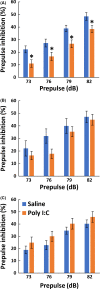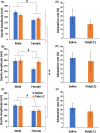Inter-breeder differences in prepulse inhibition deficits of C57BL/6J mice in a maternal immune activation model
- PMID: 34043885
- PMCID: PMC8411318
- DOI: 10.1002/npr2.12178
Inter-breeder differences in prepulse inhibition deficits of C57BL/6J mice in a maternal immune activation model
Abstract
Genetic and environmental factors interact with each other to influence the risk of various psychiatric diseases; however, the intensity and nature of their interactions remain to be elucidated. We established a maternal infection model using polyinosinic-polycytidylic acid (Poly(I:C)) to determine the relationship between the maternal breeding environment and behavioral changes in the offspring. We purchased pregnant C57BL/6J mice from three breeders and administered Poly(I:C) (2 mg/kg) intravenously in their tail vein on gestation day 15. The offspring were raised to 8-12 weeks old and subjected to the acoustic startle tests to compare their startle response intensity, prepulse inhibition levels, and degree of the adaptation of the startle response. No statistical interaction between Poly(I:C) administration and sex was observed for prepulse inhibition; thus, male and female mice were analyzed together. There was a statistical interaction between the breeder origin of offspring and prepulse inhibition; the Poly(I:C) challenge significantly decreased prepulse inhibition levels of the offspring born to the pregnant dams from Breeder A but not those from the other breeders. However, we failed to detect significant inter-breeder differences in Poly(I:C) effects on startle response and on startle adaptation with the given number of mice examined. The rearing environment of mouse dams has a prominent effect on the Poly(I:C)-induced prepulse inhibition deficits in this maternal immune activation model.
Keywords: gene-environment; polyinosinic-polycytidylic acid; prepulse inhibition; schizophrenia; startle response.
© 2021 The Authors. Neuropsychopharmacology Reports published by John Wiley & Sons Australia, Ltd on behalf of the Japanese Society of Neuropsychopharmacology.
Conflict of interest statement
The authors declare no conflict of interest.
Figures


Similar articles
-
Prenatal immune challenge in rats: effects of polyinosinic-polycytidylic acid on spatial learning, prepulse inhibition, conditioned fear, and responses to MK-801 and amphetamine.Neurotoxicol Teratol. 2015 Jan-Feb;47:54-65. doi: 10.1016/j.ntt.2014.10.007. Epub 2014 Nov 8. Neurotoxicol Teratol. 2015. PMID: 25450663 Free PMC article.
-
Relationships between the acoustic startle response and prepulse inhibition in C57BL/6J mice: a large-scale meta-analytic study.Mol Brain. 2018 Jul 13;11(1):42. doi: 10.1186/s13041-018-0382-7. Mol Brain. 2018. PMID: 30001725 Free PMC article.
-
Sexually dimorphic effects of prenatal exposure to lipopolysaccharide, and prenatal and postnatal exposure to propionic acid, on acoustic startle response and prepulse inhibition in adolescent rats: relevance to autism spectrum disorders.Behav Brain Res. 2015 Feb 1;278:244-56. doi: 10.1016/j.bbr.2014.09.032. Epub 2014 Oct 7. Behav Brain Res. 2015. PMID: 25300465
-
The risk for behavioural deficits is determined by the maternal immune response to prenatal immune challenge in a neurodevelopmental model.Brain Behav Immun. 2014 Nov;42:138-46. doi: 10.1016/j.bbi.2014.06.013. Epub 2014 Jun 26. Brain Behav Immun. 2014. PMID: 24973728
-
Effects of prenatal infection on prepulse inhibition in the rat depend on the nature of the infectious agent and the stage of pregnancy.Behav Brain Res. 2007 Aug 6;181(2):270-7. doi: 10.1016/j.bbr.2007.04.016. Epub 2007 Apr 27. Behav Brain Res. 2007. PMID: 17553574
Cited by
-
Adolescent THC Treatment Does Not Potentiate the Behavioral Effects in Adulthood of Maternal Immune Activation.Cells. 2021 Dec 11;10(12):3503. doi: 10.3390/cells10123503. Cells. 2021. PMID: 34944011 Free PMC article.
-
GABA system as the cause and effect in early development.Neurosci Biobehav Rev. 2024 Jun;161:105651. doi: 10.1016/j.neubiorev.2024.105651. Epub 2024 Apr 4. Neurosci Biobehav Rev. 2024. PMID: 38579901 Free PMC article. Review.
-
Assessment of the effects of sex, age, and rearing condition on ultrasonic vocalizations elicited by pups during the maternal potentiation paradigm in C57BL/6J mice.Dev Psychobiol. 2022 Dec;64(8):e22341. doi: 10.1002/dev.22341. Dev Psychobiol. 2022. PMID: 36426792 Free PMC article.
-
Effects of Importin α1/KPNA1 deletion and adolescent social isolation stress on psychiatric disorder-associated behaviors in mice.PLoS One. 2021 Nov 12;16(11):e0258364. doi: 10.1371/journal.pone.0258364. eCollection 2021. PLoS One. 2021. PMID: 34767585 Free PMC article.
-
Beadchip technology to detect DNA methylation in mouse faithfully recapitulates whole-genome bisulfite sequencing.Epigenomics. 2023 Feb;15(3):115-129. doi: 10.2217/epi-2023-0034. Epub 2023 Apr 5. Epigenomics. 2023. PMID: 37020391 Free PMC article.
References
-
- Watanabe Y, Someya T, Nawa H. Cytokine hypothesis of schizophrenia pathogenesis: evidence from human studies and animal models. Psychiatry Clin Neurosci. 2010;64(3):217–30. - PubMed
-
- Ozawa K, Hashimoto K, Kishimoto T, Shimizu E, Ishikura H, Iyo M. Immune activation during pregnancy in mice leads to dopaminergic hyperfunction and cognitive impairment in the offspring: a neurodevelopmental animal model of schizophrenia. Biol Psychiatry. 2006;59(6):546–54. - PubMed
-
- Zuckerman L, Rehavi M, Nachman R, Weiner I. Immune activation during pregnancy in rats leads to a postpubertal emergence of disrupted latent inhibition, dopaminergic hyperfunction, and altered limbic morphology in the offspring: a novel neurodevelopmental model of schizophrenia. Neuropsychopharmacology. 2003;28(10):1778–89. - PubMed
-
- Hida H, Mouri A, Noda Y. Behavioral phenotypes in schizophrenic animal models with multiple combinations of genetic and environmental factors. J Pharmacol Sci. 2013;121(3):185–91. - PubMed
Publication types
MeSH terms
Substances
LinkOut - more resources
Full Text Sources
Other Literature Sources

